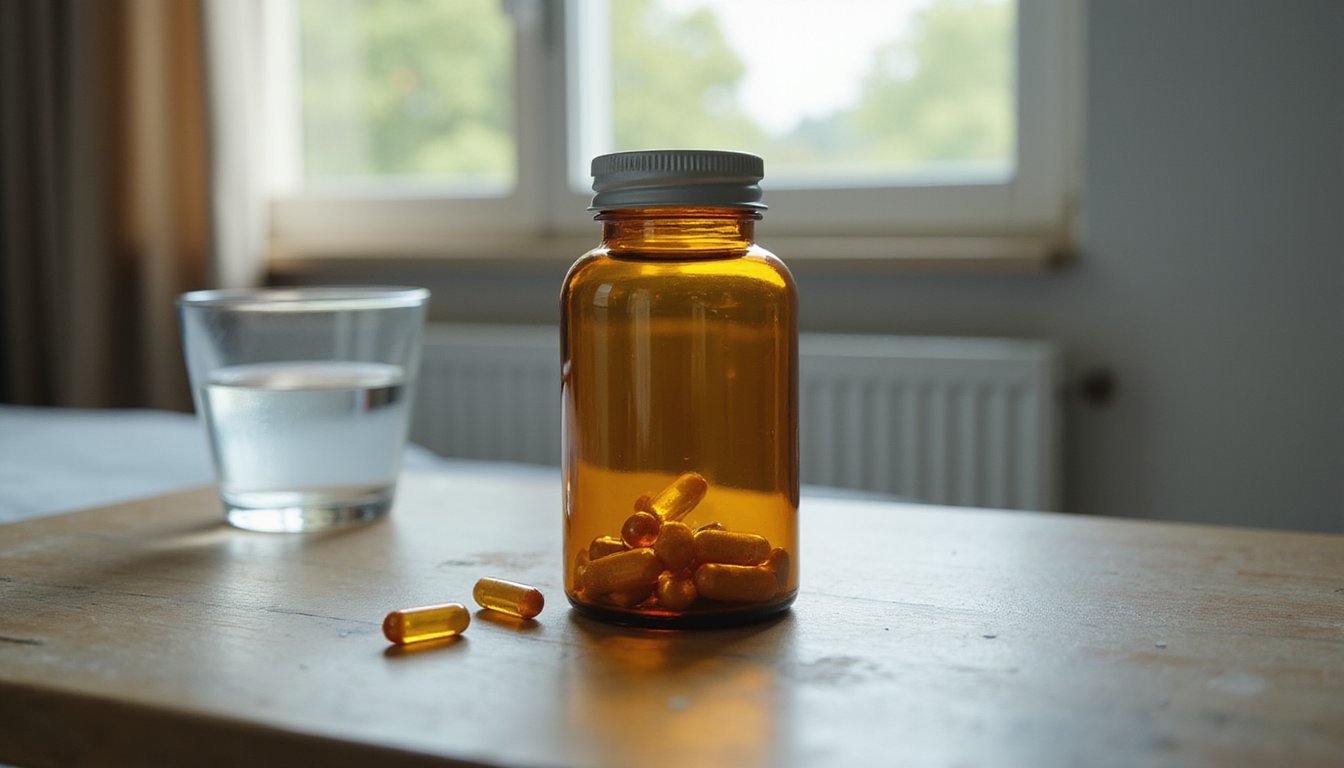FDA-approved antidepressants like fluoxetine (Prozac) and escitalopram (Lexapro) serve as first-line medications for children with depression, working by adjusting brain chemicals that affect mood. You’ll need to closely monitor your child during treatment, especially in the first 9 days when side effects are most likely. While these medications are effective, they work best when combined with therapy like CBT. Understanding the full scope of treatment options will help you make informed decisions for your child’s care.
Understanding the Basics of Pediatric Depression Medications

When treating pediatric depression, understanding medication options and their specific uses is crucial for ideal care. SSRIs, particularly fluoxetine and escitalopram, are the first-line medications your child’s doctor will likely consider. These medications typically take 4-6 weeks to show effectiveness. Research shows that combination therapy yields higher remission rates than medication alone. Nine months is typically the minimum treatment duration after symptoms improve.
You’ll want to know that while SNRIs are sometimes used for anxiety, they’re not officially approved for pediatric depression. Your doctor may prescribe medications “off-label” based on your child’s specific needs. It’s important to understand that paroxetine isn’t recommended due to increased suicide risks. The FDA requires doctors to prescribe the smallest quantity of pills possible to reduce overdose risks.
Treatment often works best when combining medication with cognitive behavioral therapy (CBT). Your child’s doctor will start with low doses and adjust gradually, carefully monitoring for side effects. Regular check-ups facilitate proper response and allow for dose adjustments as needed.
FDA-Approved Options for Children and Teens
The FDA has specifically approved two SSRIs for treating depression in young patients: fluoxetine (Prozac) for children 8 and older, and escitalopram (Lexapro) for adolescents 12 and up. These medications have demonstrated the strongest safety profile and effectiveness in clinical trials, with fluoxetine being the most extensively studied option.
Your child’s doctor may need 4-6 weeks to determine if the medication is working effectively. During this time, parental involvement is essential in monitoring for any behavioral changes or side effects. While these medications are proven treatments, they’re often prescribed alongside alternative therapies like cognitive behavioral therapy to improve outcomes. Your healthcare provider will start with low doses and adjust based on your child’s response, following established protocols to guarantee the safest and most effective treatment approach. It’s important to note that studies show antidepressant use carries a 4% risk of suicidality in young patients, which requires careful monitoring by both healthcare providers and family members.
How Antidepressants Work in Young Minds

Antidepressants influence young minds through specific neurotransmitter pathways that regulate mood, emotions, and behavior. When your child takes an antidepressant, it works by adjusting the balance of key brain chemicals, particularly serotonin, norepinephrine, and dopamine. Different medications target specific neurotransmitter combinations to achieve ideal medication efficacy. The therapeutic effects may take several weeks before parents notice significant improvements in their child’s symptoms. Research shows that these medications work by specifically blocking reuptake inhibition to increase neurotransmitter concentrations around nerve synapses.
SSRIs like fluoxetine increase serotonin levels to improve mood and emotional regulation, while SNRIs such as venlafaxine boost both serotonin and norepinephrine. Bupropion focuses on dopamine and norepinephrine, making it helpful for depression with fatigue. Studies show that fluoxetine is more efficacious than other antidepressants for treating major depressive disorder in children and adolescents. These adjustments don’t happen instantly; they require weeks or months as the brain adapts to the new neurotransmitter balance. Your child’s response will depend on their unique genetic makeup, age, and specific symptoms, which is why doctors carefully monitor and adjust treatment plans.
Safety Considerations and Potential Side Effects
Despite their therapeutic benefits, prescribing antidepressants for children requires careful consideration of safety risks and potential side effects. You’ll need to understand that all antidepressants carry FDA black box warnings about increased suicide risks, with studies showing 2-3 children per 100 may experience suicidal thoughts. Patient education and close monitoring are essential, especially during the first few weeks of treatment.
Your child might experience physical reactions like stomach upset or drowsiness, affecting about 10% of young patients. Watch for behavioral changes such as increased agitation, hostility, or impulsivity. SSRIs and sertraline are considered first-line treatments for pediatric depression. Studies show the highest risk period occurs within the first 9 days of starting treatment. Research suggests that combining antidepressants with cognitive behavioral therapy produces enhanced safety and effectiveness. It’s vital to maintain regular communication with your healthcare team about drug interactions and any concerning symptoms. While these medications can effectively treat depression, your vigilant observation and partnership with medical professionals are key to ensuring your child’s safety.
Starting Treatment: What Parents Should Know

When starting antidepressant treatment for your child, understanding medication options and processes helps guarantee ideal outcomes. During initial consultations, your doctor will likely recommend SSRIs like fluoxetine or escitalopram, which have proven safety profiles and FDA approval for young patients.
It’s essential to address common medication misconceptions early on. Your child will start with lower doses than adults receive, and you’ll need to maintain consistent follow-up appointments to monitor progress. The medication typically takes 4-6 weeks to show effectiveness, and your doctor will document side effects using standardized checklists. Multiple visits within 8 weeks are typically required to properly assess your child’s response to the medication and make any necessary adjustments.
Your doctor should provide written instructions covering dosage, administration, and follow-up care. They’ll also discuss important safety considerations, including the need to watch for behavioral changes and maintain open communication throughout the treatment process.
Monitoring Progress and Adjusting Treatment
Successful treatment of childhood depression requires vigilant monitoring and responsive adjustments to guarantee ideal outcomes. As a parent, you’ll need to actively participate in tracking symptoms and adjusting strategies throughout your child’s treatment journey. Regular communication with healthcare providers helps confirm medication effectiveness while minimizing potential side effects.
- Track daily changes in mood, behavior, and physical symptoms in a dedicated log
- Attend scheduled follow-up visits every 1-2 weeks during initial treatment
- Monitor academic performance and social interactions at school
- Report any concerning side effects or behavioral changes immediately
- Participate in collaborative discussions about medication adjustments
Your observations are essential in determining whether the current treatment plan is working effectively. If your child isn’t showing improvement after 6-8 weeks, work with their healthcare provider to reassess and modify the treatment approach as needed.
Combining Medication With Other Therapies
Research consistently shows that combining antidepressant medication with other therapeutic approaches leads to superior outcomes for children with depression. When you choose combination therapies for your child, you’re maximizing therapeutic benefits while potentially reducing medication side effects. Studies indicate that combination therapy shows greater effectiveness for achieving remission compared to using antidepressants alone. Specifically, research demonstrates that using fluoxetine with CBT produces better improvements in symptoms and daily functioning.
| Therapy Type | Benefits | Best For |
|---|---|---|
| CBT | Reduces symptoms, teaches coping skills | Ages 12+ |
| Family Therapy | Improves home dynamics, support | All ages |
| Exercise | Natural mood boost, no side effects | Active youth |
Your child’s treatment team may recommend integrating multiple approaches, as research shows this strategy is particularly effective for adolescents. While evidence for children under 12 is still emerging, combining medication with therapy often provides better long-term results than medication alone. Regular monitoring helps guarantee the treatment combination remains effective and safe for your child.
Warning Signs and When to Contact Your Doctor
While your child is taking antidepressant medication, you’ll need to watch closely for sudden changes in behavior like increased agitation, hostility, or impulsiveness that could signal a concerning medication response. Since anxiety and depression frequently occur together in children, be especially observant of both mood and anxiety-related symptoms. Physical symptoms such as unusual restlessness, severe insomnia, or unexplained energy bursts should prompt immediate contact with your child’s healthcare provider. Your healthcare provider will likely schedule weekly face-to-face visits during the first month of treatment to monitor your child’s response. Antidepressants typically require four to six weeks to show therapeutic effects, so patience during the initial treatment period is essential. Emergency warning signs that require urgent medical attention include expressions of suicidal thoughts, self-harm attempts, or a sudden sense of calm following severe depression.
Sudden Behavioral Changes
Parents should remain vigilant about sudden behavioral changes in their children, as these shifts often signal the onset or worsening of depression. When your child exhibits sudden mood swings or emotional outbursts, particularly alongside social withdrawal and academic struggles, it’s essential to recognize these as potential behavioral triggers. Pay attention to regression signs in younger children and changes in peer relationships that might indicate deeper concerns.
- Unexpected aggressive behavior or intense emotional reactions to minor situations
- Withdrawal from previously enjoyed activities and family interactions
- Noticeable decline in academic performance or difficulty concentrating
- Return to earlier developmental behaviors, especially in younger children
- Changes in social patterns, including isolation from friends or communication barriers
These behavioral changes, especially when persisting for more than two weeks, warrant professional evaluation and support to develop appropriate coping strategies.
Worsening Physical Symptoms
Children taking antidepressant medications may experience various physical symptoms that require careful monitoring and prompt medical attention. As a parent, you’ll need to watch for worsening symptoms across several key areas. Pay close attention to any visual changes or eye pain, gastrointestinal issues like nausea or appetite changes, and the onset of headaches or other neurological manifestations.
Track your child’s sleep patterns and report any significant disruptions to their doctor. Regular health assessments and side effect monitoring are essential, as medication interactions can sometimes mask or aggravate underlying conditions. Keep detailed notes of your observations, including when symptoms occur and their severity. Contact your healthcare provider immediately if you notice sudden vision problems, severe stomach distress, or persistent headaches. Your parent observations are vital in helping doctors adjust treatment plans effectively.
Emergency Warning Signs
Recognizing emergency warning signs quickly can mean the difference between life and death when your child is taking antidepressant medications. If you notice any severe changes in your child’s behavior or mood, don’t wait to implement emergency protocols. Contact your healthcare provider immediately or seek emergency services if these warning signs appear.
- Expressing thoughts about suicide or making specific plans for self-harm
- Engaging in dangerous behaviors like cutting, burning, or overdosing
- Showing extreme agitation, panic attacks, or uncontrollable fear
- Withdrawing completely from family and friends while showing hopelessness
- Experiencing hallucinations or beliefs that don’t match reality
These symptoms require immediate interventions. Keep emergency contact numbers readily available, including your child’s doctor, local crisis hotline, and nearest emergency room. Don’t leave your child alone if they’re showing these warning signs.
Supporting Your Child Through Treatment
Supporting your child through medication treatment requires consistent monitoring of any side effects through daily check-ins and a symptom tracking journal. You’ll want to establish open, trust-based communication about how the medication makes them feel, using age-appropriate tools like mood scales or drawings to help them express their experiences. Creating a predictable routine around medication times, while incorporating enjoyable activities and maintaining regular sleep schedules, will help your child feel more secure during the treatment process.
Monitoring Side Effects Daily
The daily monitoring of medication side effects plays an essential role in your child’s depression treatment success. Through consistent daily symptom tracking and side effect observations, you’ll help guarantee your child’s safety and treatment effectiveness. Watch for both physical and behavioral changes, particularly during the first month of treatment or after dose adjustments.
- Keep a detailed log of sleep patterns, appetite changes, and any unusual physical symptoms
- Note behavioral shifts, including increased agitation, restlessness, or sudden mood changes
- Document the timing and severity of side effects to share with your child’s healthcare provider
- Monitor closely for signs of suicidal thoughts or increased impulsivity, especially in youth
- Track any interactions with other medications, supplements, or over-the-counter products
Contact your child’s healthcare provider immediately if you notice concerning changes or severe side effects.
Building Trust Through Communication
While monitoring medication side effects helps guarantee physical safety, building trust through open communication forms the foundation of successful depression treatment for children. Trust building strategies start with effective listening, create a judgment-free space where your child can express their feelings openly. Ask gentle, open-ended questions about their experiences and reflect their emotions back to validate their perspective.
Suggest low-pressure activities like walks or shared meals to foster connection in comfortable settings. Avoid interrogating them about their symptoms or treatment, which can increase resistance. Instead, use motivational interviewing techniques to explore their ambivalence about therapy and medication. Frame treatment as a collaborative process where they have input in decisions. When they take small steps toward engagement, celebrate their progress while continuing to validate any lingering concerns.
Creating Routine Around Medicine
Successful medication management for children with depression depends heavily on establishing consistent daily routines. By integrating medication schedules into your child’s daily activities and creating structured support systems, you’ll help guarantee proper treatment adherence. Work with your child to develop routine adjustments that feel natural and sustainable.
- Link medication times to established activities like meals, brushing teeth, or backpack packing
- Use pill organizers and clear labels to simplify the administration process
- Set up automated reminders through mobile apps or text alerts
- Maintain consistent weekend schedules to avoid disrupting medication routines
- Create a shared tracking system that involves family members in monitoring adherence
When building these routines, remember to be flexible and responsive to your child’s needs, adjusting strategies as necessary while maintaining the core structure of medication timing and administration.
Frequently Asked Questions
Can My Child Take Medication Only During School Days?
You shouldn’t limit your child’s medication to school days only. Consistent daily medication scheduling is essential for maintaining therapeutic benefits and preventing disruption to brain chemistry. While school support is important, weekend discontinuation can lead to subtherapeutic drug levels and increased symptoms. It’s also harder to monitor side effects with irregular dosing. You’ll get the best results by following your doctor’s prescribed schedule, which typically means daily administration.
What Happens if My Child Accidentally Takes an Extra Dose?
If your child takes an extra dose, you should immediately call poison control or your healthcare provider. While a single extra dose may cause mild overdose symptoms like nausea or drowsiness, it’s vital to get professional guidance. Don’t induce vomiting unless specifically instructed. Monitor your child closely for concerning symptoms like severe confusion, rapid heartbeat, or seizures. Keep activated charcoal on hand, but only use it if directed by medical professionals.
How Do Antidepressants Affect My Child’s Growth and Development?
While antidepressants can affect growth milestones, most changes are mild and temporary. You might notice slight weight gain as a common medication side effect, particularly with sertraline. Studies show minimal long-term impact on physical development when properly monitored. Your child’s doctor will track their height, weight, and motor skills regularly. It’s important to remember that untreated depression can pose greater risks to your child’s overall development than medication side effects.
Will My Child Need to Take These Medications Forever?
Your child won’t necessarily need antidepressants forever. Most treatment plans recommend continuing medication for 9-12 months after symptoms improve. Doctors carefully evaluate long-term effects and individual progress before considering medication tapering. If your child remains stable for about two years, gradual discontinuation may be possible. However, some children might need extended treatment, especially if they experience multiple relapses or have complex risk factors.
Can My Child Participate in Competitive Sports While Taking Antidepressants?
Yes, your child can participate in competitive sports while taking antidepressants, but you’ll need to monitor their medication side effects and sports performance closely. Work with their healthcare provider to track any impacts on coordination, stamina, or hydration needs. It’s important to communicate openly with coaches about your child’s needs while maintaining privacy. Regular check-ins about their physical and emotional well-being will help guarantee they’re getting the most benefit from both their medication and athletic participation.






